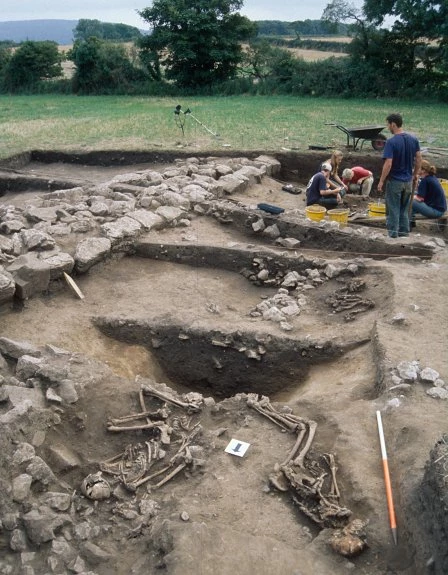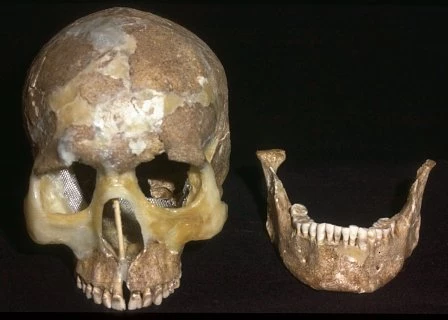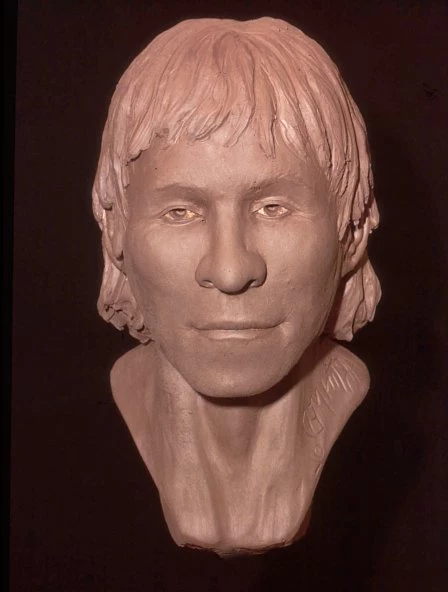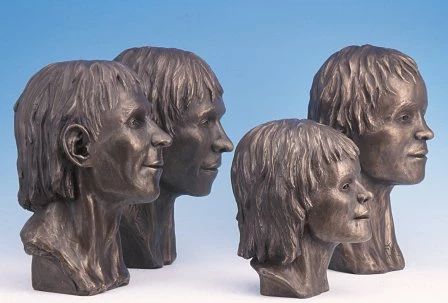Science brings to life the witnesses to the Viking-age in North Wales
Excavating the enclosure ditch and skeletons at Llanbedrgoch (Anglesey). To the left of the image are the lower courses of the settlement's defensive wall. Two of the skeletons can be seen lying in the upper levels of the ditch that lay outside this wall.
The skull of burial 5. This skull was in pieces when discovered and has since been reconstructed. Photo by the School of Art and Medicine, University of Manchester.
The face of burial 5 after recreation. Photo by the School of Art and Medicine, University of Manchester.
Four of the five faces from Llanbedrgoch, cast in brass.
Excavations by the National Museum of Wales on the early medieval settlement at Llanbedrgoch on Anglesey, North Wales, have unlocked details of life in 9th- and 10th-century Wales. Scientific techniques have allowed the faces of four of those that lived there to be recreated from their skulls.
A puzzling discovery
In 1998, an unexpected discovery was made on the west side of the settlement. Five human skeletons were found in the upper level of a filled-in ditch immediately outside a defensive wall that surrounded the settlement. Contrary to usual Christian practice, all skeletons were aligned with their heads either to the north or south rather than to the east possibly influenced by the position of the wall.
They appear to have been casually buried in shallow graves. Three of the bodies had been buried individually, but there was one double burial in which an adult male (approximately 23-35 years old) had been thrown directly on top of a child (approximate age 10-15 years old). The adult male's arms may have been tied behind his back and he may have suffered a blow to the left eye with a sharp object. Another older adult male (35-45 years old) appears to have been placed face down, turned to left, body slightly twisted, and he may have had his wrists fastened in front of his body.
In the case of three of the burials, the bodies were covered by scattered limestone blocks and smaller rubble, probably derived from the collapse of the enclosure wall. This suggests they were buried shortly before the abandonment of the site.
The Llanbedrgoch skeletons date to the second half of the 10th century, a period when Vikings on the Isle of Man effectively controlled Gwynedd, and may have had bases on Anglesey. The circumstances of burial and lack of Christian orientation have led to speculation that these individuals were victims of raiding. The precise circumstances of their deaths may never be known, but they may have been the victims of military activity by Vikings in their search for wealth, perhaps in the form of hostages or slaves.
The Llanbedrgoch skulls show a number of similar features, including horizontal eye fissures, square jaws and adherent ears (they were lacking ear-lobes). Some of these features suggest a genetic relationship between the individuals. Either they belonged to the same families or the individuals came from a small gene pool.
Not only has the site produced a wealth of evidence for settlement layout, buildings, artefacts and standards of living on a high status site - it has also provided the remains of people who once breathed and walked there.
Background Reading
Vikings in Wales: an archaeological quest by Mark Redknap. Published by the National Museums & Galleries of Wales (2000).



